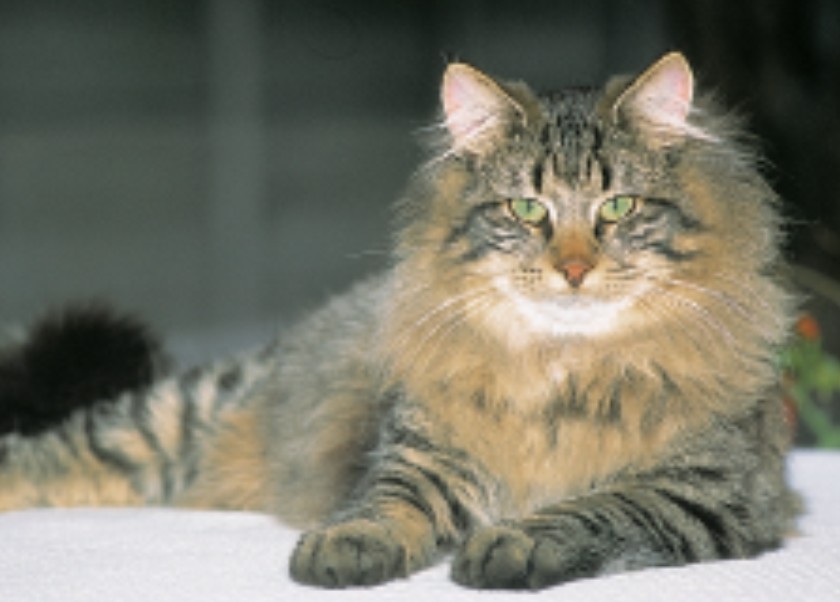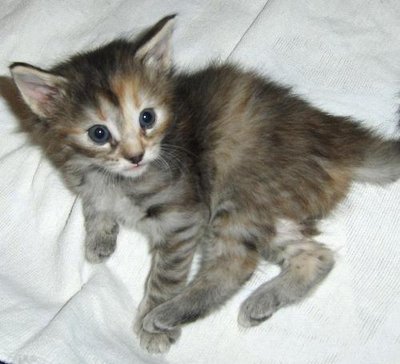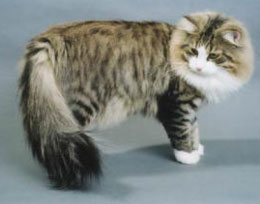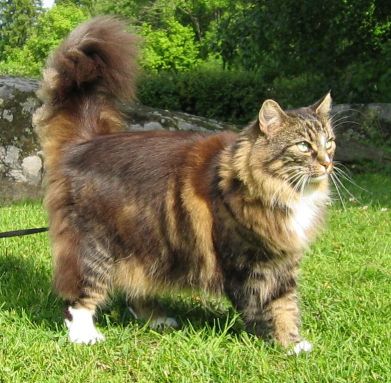



|
Norwegian Forest Cat Description
A stunning cat with long, flowing coat and shining green eyes with a band of gold encircling them; the Norwegian Forest Cat is a beauty to have and behold. Slow maturing, this cat takes five years to grow its magnificent coat; the breed has survived for centuries in the harsh northern climate of Norway. It is a study cat with water resistant guard hairs and a downy under coat. Twice a year they will go through a drastic coat change, losing their undercoat and guard hairs, but keeping the length. The hair on the tail remains long throughout, and can spread as far as twelve inches or more when fully fanned. A dense mane decorates their neck. Their inner ear can posses tufts of hair that grow to be three or four inches long. Every color and pattern are accepted, except those that are the result of hybridization: chocolate, sable, lilac, lavender, cinnamon, fawn, himalayan-type markings, or any of these with white.
Their head is an equilateral triangle, measured from the outside base of the ear to the chin. Ears are medium to large, rounded at the tip, and set as much on the side of the head as on the top. They are alert and heavily furnished, with lynx tips desired but not required. Eyes should be large and almond-shaped, well-opened and expressive. Acceptable colors are green, gold, green-gold, or copper; white cats or those with white may have blue or odd-eyes.
The body should be solidly muscled and well-balanced, with moderate length and substantial bone structure. Males should be large and imposing; females may be smaller and more refined. Legs should be medium with longer hind legs; paws are large, round and firm with heavy tufting.
Norwegian Forest Cat Temperament
This is a very people oriented and nuturing breed. They love to mother everyone and will happily hold down cat, dog or person and administer a loving bath. They are strong and silent, but possess a loud, rumbling purr. It is a necessity that the Norwegian Forest Cat have something to climb. If you don't provide a way for them to survey their kingdom they will find one themselves.
Norwegian Forest Cat Care
The Norwegian Forest Cat requires very little care. Brushings are only recommended during shedding as they help to prevent hair balls.
Norwegian Forest Cat History
The Norwegian Forest Cat, or skogkatt, appeared about 4000 years ago and has been around in mythology since the vikings and written Edda poems from between 800 and 1200 AD. They protected the grain both on land and sea, and are believed to have left traces of themselves in North America.
For a long time it was seen as simply a domestic house pet, and efforts to breed it as a distinct breed in Norway did not begin until the 1930's. They were almost lost by that time to hybridization with free-roaming shorthairs and it took the realization that a national treasure was being bred out of existence before efforts were made to save it. As with many cat breeds in Europe, however, World War II nearly decimated them. The Wegie, as it is nicknamed, likely made its first landing in North America with Lief Erikson; their modern arrival was in 1979. They were a hit, receiving TICA recognition in 1984, CFA Championship status in 1993, and ACA recognition in 1995.
|